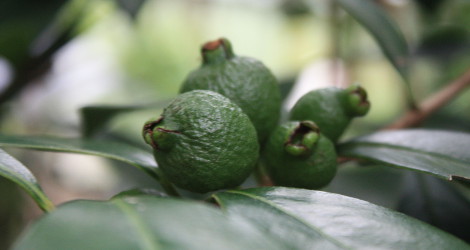Accession Data:
Manilkara zapota (L.) Van Royen
- Common Name: Naseberry
- Family: Sapotaceae Juss.
- Description: The sapodilla is an attractive upright, slow-growing, long-lived evergreen tree. Distinctly pyramidal when young, with age the tree may develops a crown that is dense and rounded or sometimes open and somewhat irregular in shape. The leaves are 3 to 4-1/2 inches long and 1 to 1-1/2 inches wide. They are medium green, glossy, alternate and spirally clustered at the tip of forked twigs. Flowers are small, inconspicuous and bell-like, approximately 3/8 inch in diameter. They are borne on slender stalks in the axil of the leaves. There are several flushes of flowers throughout the year. The fruit is round to egg-shape, 2 - 4 inches in diameter. The skin is brown and scruffy when ripe. The flesh varies from yellow to shades of brown and sometimes reddish-brown, and may be smooth or of a granular texture. The flavor is sweet and pleasant, ranging from a pear flavor to crunchy brown sugar. Fruits can be seedless, but usually have from 3 to 12 hard, black, shiny, flattened seeds about 3/4 inch long in the center of the fruit.1
- Uses: Chicle, the latex obtained from the bark of the tree has been used as a chewing gum base for many years.
- USDA Zone: 10b-11
Accession Data:
- Accession # 201900362
- Source: Mario Sousa-Pena
- Provenance:
Seeds from fruit purchased at a Mexican products store in Meriden, CT. Fruit imported from Mexico.
- Accession Date: 08-05-2019
- Bench: 1309 - NEOA: Ground Bed 1 SW
- Currently: active - healthy
- Qty: 1 confirmed on 01-30-2025
Classification:
- Division: Magnoliophyta
- Class: Magnoliopsida
- SubClass: asterids
- Order: Ericales
- SubOrder:
- Family: Sapotaceae
- SubFamily: Sapotoideae
- Tribe: Sapoteae
- SubTribe:
References (internal):
- EEB Greenhouse Holdings native to: Mexico Central / Mexico Northeast / Mexico Gulf / Mexico Northwest / Mexico Southwest / Mexico Southeast / Belize / Costa Rica / El Salvador / Guatemala / Honduras / Nicaragua / Panama / Colombia
References (external):
- California Rare Fruit Growers Web Site. Last accessed on Monday, 05 August, 2019.
- The Plant List (2013). Version 1.1. Last accessed on Monday, 05 August, 2019.
- WCSP (2017). World Checklist of Selected Plant Families. Facilitated by the Royal Botanic Gardens, Kew. Last accessed on Monday, 05 August, 2019.
- Chicle at Wikipedia. Last accessed on Monday, 05 August, 2019.
- Image #00 (cropped) & #01 (original) by Stephencdickson (Own work) [CC BY-SA 4.0], via Wikimedia Commons. Last accessed on Wednesday, October 25, 2017.
data regenerated on Thu, 30 Jan 2025 13:27:05 -0500 [bcm v4.0]
Images:

Additional images for this accession:
Click on thumbnails to enlargeCurrent Accessions in the Sapotaceae
Subfamily Chrysophylloideae
Subfamily Sapotoideae
Tribe Sapoteae
W/C = Wild Collected
 = indicates flowering in past 14 days
= indicates flowering in past 14 days
 = images available for this accession
= images available for this accession
 = map available for this accession
= map available for this accession
 = accession added within past 90 days
= accession added within past 90 days

